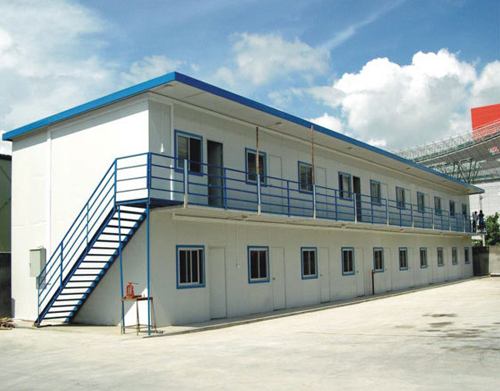近年来,钢结构板房因其建造周期短、成本可控、可移动性强等特点,在禹城及周边地区的临时建筑、工地办公、应急安置等领域广泛应用。然而,随着公众意识的提升,关于钢结构板房是否含有甲醛的疑问逐渐增多。本文将从材料构成、工艺特性、环境影响等维度,系统解析钢结构板房的甲醛问题。
In recent years, steel structure panel houses have been widely used in temporary buildings, construction site offices, emergency resettlement, and other fields in Yucheng and surrounding areas due to their short construction period, controllable cost, and strong mobility. However, with the increasing public awareness of environmental protection, questions about whether steel structure panel houses contain formaldehyde are gradually growing. This article will systematically analyze the formaldehyde problem in steel structure panel houses from dimensions such as material composition, process characteristics, and environmental impact.
一、钢结构板房的材料构成与甲醛来源
1、 Material composition and formaldehyde sources of steel structure panel houses
钢结构板房的主体结构由钢柱、钢梁、檩条等构件组成,这些金属材料本身不含甲醛。甲醛释放主要来源于以下两类材料:
The main structure of the steel structure panel house is composed of steel columns, steel beams, purlins and other components, and these metal materials themselves do not contain formaldehyde. Formaldehyde emissions mainly come from the following two types of materials:
围护板材
Enclosure board
彩钢夹芯板:作为常见的墙体和屋面材料,其芯材可能涉及甲醛问题。聚苯乙烯(EPS)夹芯板在生产过程中若使用脲醛树脂作为胶黏剂,可能残留微量甲醛。
Color steel sandwich panel: As the most common wall and roof material, its core material may involve formaldehyde issues. If urea formaldehyde resin is used as an adhesive in the production process of polystyrene (EPS) sandwich panels, trace amounts of formaldehyde may remain.
岩棉/玻璃棉板:以玄武岩或玻璃纤维为原料,经高温熔融制成,属于无机材料,甲醛释放风险极低。
Rock wool/glass wool board: made from basalt or glass fiber as raw materials, melted at high temperature, belonging to inorganic materials, with extremely low risk of formaldehyde release.
金属雕花板:表面采用金属压花工艺,内层为阻燃聚氨酯或聚苯乙烯,需关注发泡剂的性能。
Metal carved board: The surface adopts metal embossing technology, and the inner layer is made of flame-retardant polyurethane or polystyrene. Attention should be paid to the environmental performance of the foaming agent.
室内装饰材料
Indoor decorative materials
地板:PVC地板、复合地板在生产中可能添加含甲醛的胶黏剂,需选择符合GB 18580《室内装饰装修材料 人造板及其制品中甲醛释放限量》标准的产品。
Flooring: PVC flooring and composite flooring may contain adhesives containing formaldehyde during production, and products that comply with the GB 18580 standard for formaldehyde emission limits in indoor decorative materials, artificial boards, and their products should be selected.
隔断材料:石膏板、硅酸钙板等轻质隔墙若使用劣质胶黏剂,可能成为甲醛释放源。
Partition materials: Lightweight partition walls such as gypsum board and calcium silicate board may become a source of formaldehyde release if inferior adhesives are used.
密封胶与涂料:门窗密封胶、内墙涂料若含挥发性有机化合物(VOCs),可能伴随甲醛释放。
Sealing glue and coating: If door and window sealing glue and interior wall coating contain volatile organic compounds (VOCs), they may be accompanied by formaldehyde release.
二、甲醛释放的关键影响因素
2、 Key influencing factors of formaldehyde release
材料质量等级
Material quality grade
型板材:选择E0级(甲醛释放量≤0.5mg/L)或ENF级(≤0.025mg/m³)人造板,可显著降低甲醛风险。
Environmentally friendly board: Choosing E0 grade (formaldehyde emission ≤ 0.5mg/L) or ENF grade (≤ 0.025mg/m³) artificial board can significantly reduce the risk of formaldehyde.
低成本替代品:部分低价夹芯板可能采用脲醛树脂胶,需谨慎选择。
Low cost alternatives: Some low-priced sandwich panels may use urea formaldehyde resin adhesive, so careful selection is necessary.

施工工艺
Construction technology
现场切割:板材切割过程中可能破坏表面封边,加速甲醛释放。建议采用工厂预制、现场组装工艺。
On site cutting: During the cutting process of the board, the surface edge may be damaged, accelerating the release of formaldehyde. Suggest using factory prefabrication and on-site assembly processes.
密封处理:板缝、接缝处若未做密封处理,可能形成甲醛扩散通道。
Sealing treatment: If the board joints and seams are not sealed, formaldehyde diffusion channels may form.
使用环境
Usage environment
温度与湿度:甲醛释放量随温度升高而增加,湿度大于60%时释放速度加快。禹城夏季高温环境可能加剧短期释放。
Temperature and humidity: The release of formaldehyde increases with temperature, and the release rate accelerates when the humidity exceeds 60%. The high temperature environment in Yucheng during summer may exacerbate short-term releases.
通风条件:密闭空间内甲醛浓度易累积,需通过机械通风或自然通风稀释。
Ventilation conditions: Formaldehyde concentration is prone to accumulate in enclosed spaces and needs to be diluted through mechanical ventilation or natural ventilation.
三、甲醛检测与控制建议
3、 Suggestions for formaldehyde detection and control
检测方法
Testing method
现场检测:采用便携式甲醛检测仪,监测板材接缝、家具密集区域,检测前需密闭空间12小时。
On site testing: A portable formaldehyde detector is used to monitor the joints of the board and areas with dense furniture. A sealed space must be used for 12 hours before testing.
实验室检测:委托CMA认证机构,依据GB/T 18883《室内空气质量标准》进行采样分析。
Laboratory testing: Commissioned CMA certification agency to conduct sampling and analysis in accordance with GB/T 18883 "Indoor Air Quality Standards".
控制措施
Control measures
源头控制:优先选用岩棉/玻璃棉夹芯板,要求供应商提供甲醛检测报告;室内装饰材料选择水性涂料、无醛胶黏剂。
Source control: prioritize the use of rock wool/glass wool sandwich panels, and require suppliers to provide formaldehyde testing reports; Choose water-based coatings and formaldehyde free adhesives as indoor decoration materials.
过程管理:施工阶段避免破坏板材保护层,板缝处使用密封胶,完工后进行清洁与通风。
Process management: During the construction phase, avoid damaging the protective layer of the board, use environmentally friendly sealant at the board joints, and conduct comprehensive cleaning and ventilation after completion.
后期治理:通过放置活性炭、安装空气净化器、种植绿萝等植物辅助净化空气。
Post treatment: By placing activated carbon, installing air purifiers, and planting plants such as green ivy to assist in purifying the air.
四、科学认知与主动防控
4、 Scientific cognition and proactive prevention and control
钢结构板房的甲醛问题并非必然存在,其风险取决于材料选择、施工工艺与使用管理。通过以下方式可有效控制风险:
The formaldehyde problem in steel structure panel houses is not necessarily present, and its risk depends on material selection, construction technology, and usage management. The following methods can effectively control risks:
合同约束:在租赁或采购合同中明确条款,要求提供甲醛检测合格证明。
Contractual constraints: Clearly state environmental protection clauses in leasing or procurement contracts and require the provision of formaldehyde testing certificates.
验收把关:完工后委托第三方检测,确保空气质量达标后再投入使用。
Acceptance check: After completion, entrust a third party to conduct testing to ensure that the air quality meets the standards before putting it into use.
长期监测:对于长期使用的板房,建议每季度进行一次空气质量检测。
Long term monitoring: For long-term use of prefabricated houses, it is recommended to conduct air quality testing once every quarter.
钢结构板房的甲醛问题需以科学态度对待,既不必过度恐慌,也不可忽视潜在风险。通过选择材料、优化施工流程、加强后期管理,可实现使用与要求的平衡。随着绿色建材技术的进步,低甲醛、无甲醛的钢结构板房产品正在逐步普及,这将为禹城地区的临时建筑提供更健康的解决方案。
The formaldehyde problem in steel structure panel houses should be treated with a scientific attitude, without excessive panic or ignoring potential risks. By selecting environmentally friendly materials, optimizing construction processes, and strengthening post management, a balance between safe use and environmental requirements can be achieved. With the advancement of green building materials technology, low formaldehyde and formaldehyde free steel structure panel house products are gradually becoming popular, which will provide a healthier solution for temporary buildings in Yucheng area.
本文由禹城钢结构板房友情奉献.更多有关的知识请点击:http://www.lxcaigang.com真诚的态度.为您提供为的服务.更多有关的知识我们将会陆续向大家奉献.敬请期待.
This article is a friendly contribution from Yucheng Steel Structure Plate House For more information, please click: http://www.lxcaigang.com Sincere attitude To provide you with comprehensive services We will gradually contribute more relevant knowledge to everyone Coming soon.